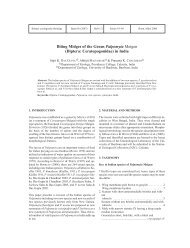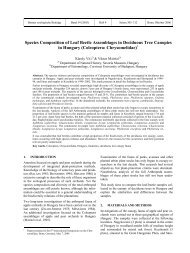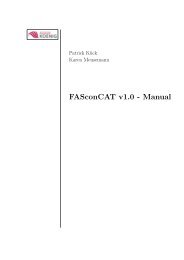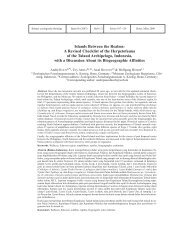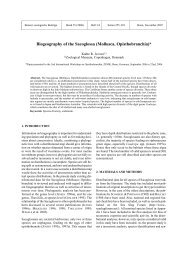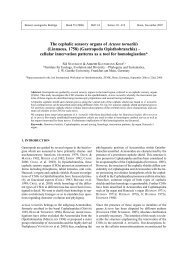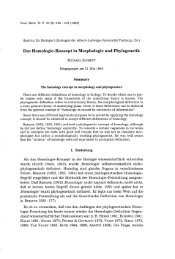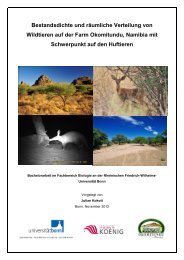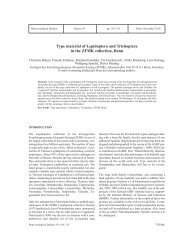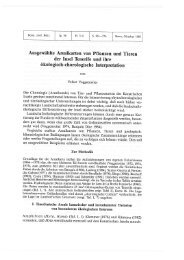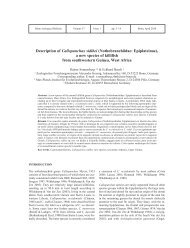Successful Husbandry and First Breeding of Varanus juxtindicus ...
Successful Husbandry and First Breeding of Varanus juxtindicus ...
Successful Husbandry and First Breeding of Varanus juxtindicus ...
Create successful ePaper yourself
Turn your PDF publications into a flip-book with our unique Google optimized e-Paper software.
was important to control the feeding because juvenile V.<br />
<strong>juxtindicus</strong> can hurt each other severely. If necessary, the<br />
young monitors were fed separately.<br />
Development <strong>of</strong> the Juveniles<br />
Body Proportions <strong>and</strong> Weight<br />
The development <strong>of</strong> the juveniles during the first year<br />
is documented in Diagrams 1 through 5. As expected,<br />
the increase in body mass showed the highest values<br />
(Diagram 1). While the hatchlings weighed 23.1 g on<br />
average at birth, after a year their weight had increased<br />
by a factor <strong>of</strong> 10. The values <strong>of</strong> the increase in snoutvent<br />
length in all specimens were similar (Diagram 3),<br />
probably because the quantitatively <strong>and</strong> qualitatively<br />
equal food allowance enabled a similar development.<br />
After one year, snout-vent lengths varied between 20.7<br />
<strong>and</strong> 27.4 cm (mean = 24.0 cm). In contrast, the growth<br />
in tail lengths shows a noticeably divergent progress<br />
(Diagram 4), a physiological feature which is apparently<br />
genetically fixed <strong>and</strong> thus not affected by targeted<br />
feeding. In addition, variation in growth rates may be<br />
related to the sex <strong>of</strong> the specimens, but this information<br />
was not available. Correspondingly, the clearly divergent<br />
values <strong>of</strong> the total length are foremost the result <strong>of</strong><br />
the individually divergent increase in tail lengths (see<br />
BIAWAK VOL. 3 NO. 4<br />
117<br />
Diagram 2). Regarding the relation between snout-vent<br />
length <strong>and</strong> tail length, juveniles <strong>of</strong> V. <strong>juxtindicus</strong> hatch<br />
with relatively short tails – common among all monitor<br />
species studied on this variable (Mertens, 1942; Horn<br />
<strong>and</strong> Visser, 1991). The development <strong>of</strong> the head <strong>and</strong><br />
body with the essential organs claims the maximal space<br />
in the egg (Horn <strong>and</strong> Visser, 1991).<br />
Within the first weeks, the relation <strong>of</strong> snout-vent to<br />
tail was clearly shifted in favor <strong>of</strong> tail length (Diagram<br />
5). At six months, the highest relative values loomed<br />
<strong>and</strong>, at the same time, the highest discrepancy between<br />
absolute maximal <strong>and</strong> minimal amount. Up until the first<br />
year, the relative tail length decreased again marginally,<br />
while maximal <strong>and</strong> minimal values approximated<br />
strongly (Diagram 5). At that time, the tail length was<br />
approximately 1.5 times the snout-vent length. This<br />
proportion between tail length <strong>and</strong> snout-vent length<br />
is also found in other monitor species (e.g., V. indicus<br />
<strong>and</strong> V. salvator), which are predominantly terrestrial or<br />
aquatic, while arboreal species have much longer tails<br />
<strong>and</strong> desert species <strong>of</strong>ten have shorter tails (Mertens,<br />
1942; Horn <strong>and</strong> Visser, 1991).<br />
Change in Color Pattern<br />
Dorsally, hatchlings <strong>of</strong> V. <strong>juxtindicus</strong> show a dense<br />
pattern <strong>of</strong> small <strong>and</strong> large whitish spots arranged in<br />
Diagram 5. Increase in mean SVL:TL ratio <strong>of</strong> V. <strong>juxtindicus</strong> <strong>of</strong>fspring (n = 8) during the first year.




